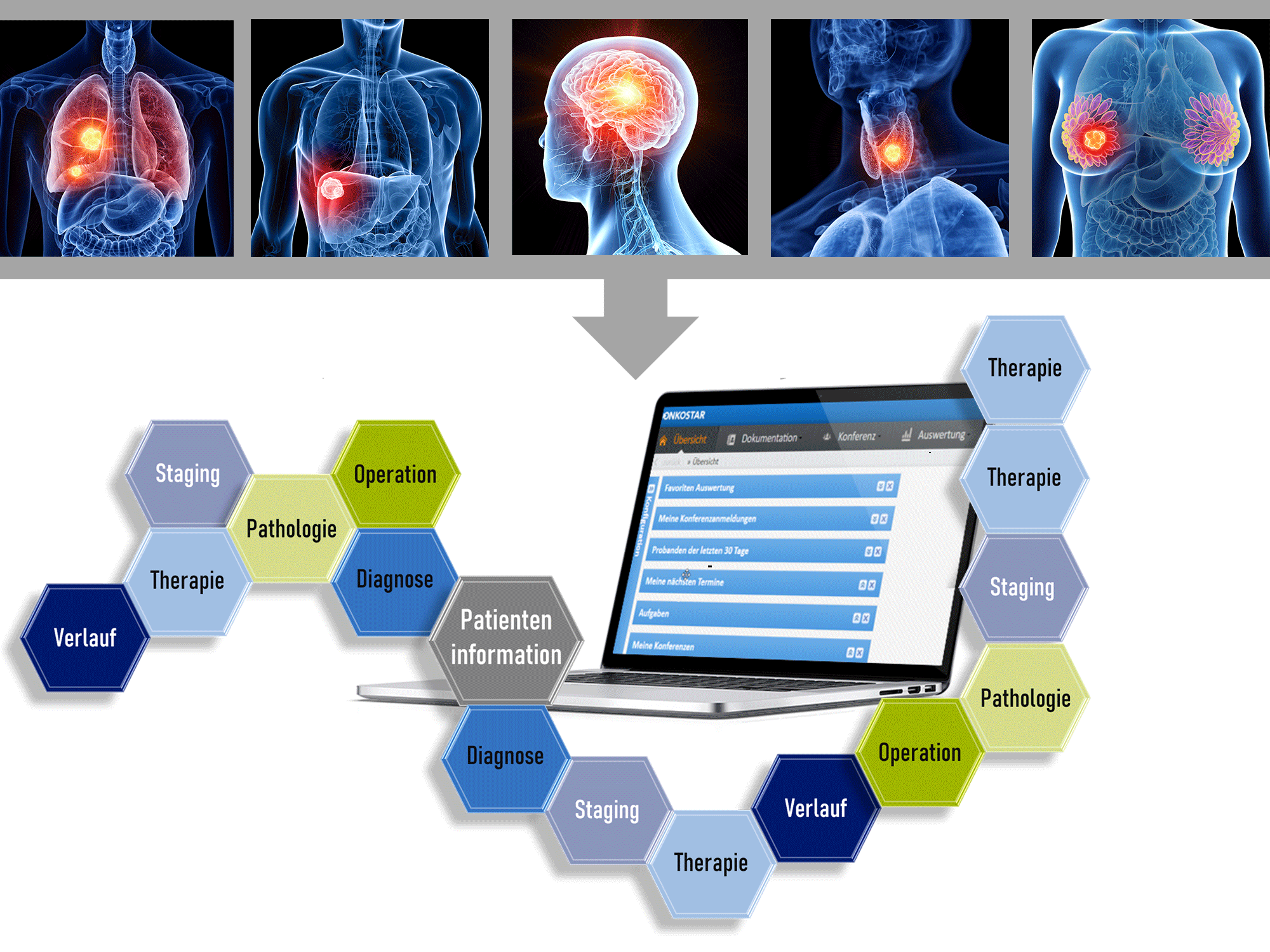NCT Cancer Registry

Tasks and objectives
A clinical cancer registry is an essential part of a tumor center. All medical data of the oncological patients are recorded and documented in an evaluable manner. At the NCT Cancer Registry, this also includes patients who seek a second opinion as well as patients who are re-treated at the NCT Heidelberg at an advanced stage of their disease. An estimated 13,000-14,000 new cancer patients are enrolled annually.
The specially trained employees of the NCT cancer registry use the tumor documentation system Onkostar from IT Choice, Karlsruhe, to record the huge amounts of data. The manuals for tumor documentation, diagnosis, course of therapy, stage, etc., developed at the NCT Heidelberg are systematically documented in a standardized and quality-compliant manner.
The primary goal of this data acquisition is not only quality control in cancer treatment, but also to support future research projects.
NCT cancer registry focus:
- Compliance with the legally stipulated obligation to report to the Baden-Württemberg State Cancer Register (C diagnoses, certain D diagnoses).
- Data collection for research projects at regular intervals:
- Physicians and scientists at the NCT can either call up their data from the register and evaluate them themselves or have evaluations carried out via the NCT cancer registry.
- The clinical cancer registry provides the basis for reports to sponsors and certifying institutions (e.g. annual reports, German Cancer Aid).
- Support with the certification of oncological centers at NCT Heidelberg (specific, detailed documentation and collection of key figures) as well as with quality assurance in the treatment of oncological diseases.
- Implementation of internal research projects on methodology and research in tumor documentation.
- The NCT cancer registry also serves as a training facility for medical tumor documentaries.
Team
- Dr. Antje Brockschmidt
Dipl.-Biologist
- Sandra Grosch
- Dr. Beate Köper
- Sophia Schäfer
- Sonja Karam
- Katrin Tröltzsch
- B. A.
- Daniela Beister
- Birgit Dold
- Raissa Gerlinski
- Jeanett Glomm
- Fiona Grätz
- Natalie Hock
- Melanie Kilgus
- Christiane Lautenschläger
- Ursula Major
- Dr. Christine Philipps
- Björn Ströter
- Annemarie Terhalle
- Laura Zimmer
- Christian Fagherazzi
- Carla Schleyer
Handbooks for general and organ-specific tumor documentation
In order to be able to compare and evaluate the data from the NCT cancer registry, they are encrypted according to national and international regulations. This set of rules has been compiled in handbooks. These give an insight into the way the data are stored. The handbooks are available for download below.
They contain recommendations for encryption, rules for documentation, tumor classifications for specific organs, anatomically confined organ areas and organ systems. Furthermore: code ICD-O-3 histology according to WHO classification, ICD-O-3-localization, ICD-10-diagnosis, regional lymph nodes, multiple tumors, tumor-specific staging, classification etc. Users are requested to adhere to the citation rules given in the handbooks.
- Handbook for general tumor documentation
- Mammary tumors
- Tumors of the central nervous system
- Tumors of the digestive system
- Tumors of the endocrine organs
- Tumors of the eye, eye adnexa and orbit
- Tumors of the female reproductive organs and the peritoneum
- Tumors in the head and neck area
- Tumors of the hematopoietic and lymphoid tissues
- Tumors of the skin
- Tumors of soft tissue and bones
- Tumors of the lung, pleura, thymus and the heart
- Tumors of the urinary and male genital organs
- Handbook for general tumor documentation
- Tumors of the eye, eye adnexa and orbit
- Tumors of the endocrine organs
- Tumors of the hematopoietic and lymphoid tissues
- Tumors of the urinary and male genital organs
- Tumors of the skin
- Tumors in the head and neck area
- Tumors of the lung, pleura, thymus and the heart
- Mammary tumors
- Tumors of the female reproductive organs and the peritoneum
- Tumors of soft tissue and bones
- Tumors of the digestive system
- Tumors of the central nervous system
- Handbook for general tumor documentation
- Tumors of the eye, eye adnexa and orbit
- Tumors of the endocrine organs
- Tumors of the hematopoietic and lymphoid tissues
- Tumors of the urinary and male genital organs
- Tumors of the skin
- Tumors in the head and neck area
- Tumors of the lung, pleura, thymus and the heart
- Mammary tumors
- Tumors of the female reproductive organs and the peritoneum
- Tumors of soft tissue and bones
- Tumors of the digestive system
- Tumors of the central nervous system
- Handbook for general tumor documentation
- Tumors of the endocrine organs
- Tumors of the hematopoietic and lymphoid tissues
- Tumors of the urinary and male genital organs
- Tumors of the skin
- Tumors in the head and neck area
- Tumors of the lung, pleura, thymus and the heart
- Mammary tumors
- Tumors of the female reproductive organs and the peritoneum
- Tumors of soft tissue and bones
- Tumors of the digestive system
- Tumors of the central nervous system








